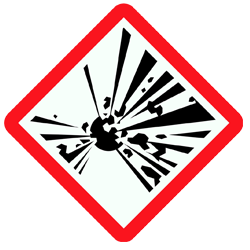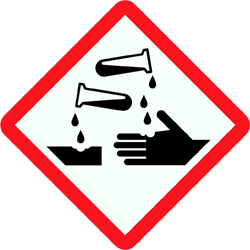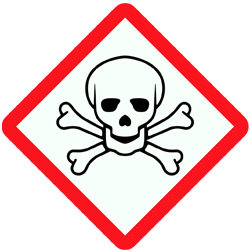Decoding GHS: Understanding Hazard Symbols on Chemical Labels
6th February 2024
6th February 2024
Chemical products, from household cleaners to industrial solvents, can pose a range of hazards if not handled properly. To ensure user safety, chemical labels are designed to communicate these hazards effectively. The Globally Harmonized System of Classification and Labelling of Chemicals (GHS) has standardized hazard symbols and pictograms, making them universally recognized and easy to interpret. Here’s a breakdown of these important symbols:

The explosion symbol, represented by a stylized bomb, indicates chemicals that pose a risk of explosion. These chemicals may be unstable or become explosive under certain conditions, such as heat, shock, or static electricity.

The flammable symbol, a flame, identifies chemicals that can easily ignite and burn. These chemicals, including solvents, paints, and gasoline, can cause serious burns if not kept away from heat sources and open flames.

The oxidizer symbol, a flame within a circle, denotes chemicals that can cause or accelerate the burning of other substances. These chemicals release oxygen, enhancing the combustibility of flammable materials. Handle oxidizers carefully and avoid contact with flammables.

The corrosive symbol, a hand dissolving in acid, indicates chemicals that can cause severe damage to human skin, eyes, and other tissues. These acids and alkalis may cause burns, irritation, and scarring. Wear gloves, goggles, and protective clothing when handling corrosives.

The toxic symbol, the skull and crossbones, warns of chemicals that can cause acute or chronic adverse health effects, including poisoning, organ damage, and even death. Follow strict safety precautions when handling toxic chemicals, including using personal protective equipment and avoiding inhalation and ingestion.

The health hazard symbol, an exclamation point inside a diamond, alerts to chemicals that may cause respiratory, skin, eye, or other health problems. These chemicals may be irritants, sensitizers, or carcinogens. Read the hazard statements and precautionary statements on the label to understand the specific risks.

The environmental hazard symbol, an animal and plant within a circle, indicates chemicals that pose a risk to the environment. These chemicals can harm aquatic life, wildlife, or the soil. Dispose of hazardous chemicals properly to avoid environmental contamination.
In addition to hazard symbols, chemical labels contain precautionary statements that provide instructions for safe handling, storage, and disposal. These statements, such as “Wear gloves,” “Store in a cool, dry place,” and “Do not flush into drains,” guide individuals in minimizing exposure and preventing accidents.
GHS labels are crucial for ensuring the safety of workers, consumers, and the environment. By understanding the symbols, statements, and precautions outlined on chemical labels, individuals can take appropriate actions to prevent accidents, protect themselves from harm, and minimize the negative impact on the environment.
Chemicals are essential for various aspects of our lives, but they also pose potential hazards. GHS hazard symbols and precautionary statements are essential tools for communicating these risks and promoting safe handling. By understanding these symbols and adhering to the safety guidelines, we can work together to minimize the risks associated with chemicals and protect human health and the environment.
Fill out the form provided to access your free trial of the LabelDirect Software.
Fill out the short form below to access the Static Cling Window Labels product specification (PDF).
Fill out the short form below to access the PP Matt Self-Adhesive Labels product specification (PDF).
Fill out the short form below to access the Hi-Tac Self Adhesive Labels product specification (PDF).
Fill out the short form below to access the High Temperature Polyester product specification (PDF).
Fill out the short form below to access the High Temperature PI Tag product specification (PDF).
Fill out the short form below to access the High Temperature PCP product specification (PDF).
Fill out the short form below to access the Thermo-Tag 600 product specification (PDF).
Fill out the short form below to access the PP Gloss Self-Adhesive Labels product specification (PDF).
Fill out the short form below to access the Rip Proof Tags product specification (PDF).
Fill out the short form below to access the Polyolefin Self Adhesive Labels product specification (PDF).
Fill out the short form below to access the Thermaplas 200 Labels product specification (PDF).
Fill out the short form below to access the Laserplas Printable Self-tie Loop Locks product specification (PDF).
Fill out the short form below to access the Mattrans Extreme product specification (PDF).
Fill out the short form below to access the Hi-Tack Gloss & Matt PP Labels product specification (PDF).
Fill out the short form below to access the Polyplas Colours 250 Self-tie Tags product specification (PDF).
Fill out the short form below to access the Carcass Tags product specification (PDF).
Fill out the short form below to access the Metal Detectable Tags product specification (PDF).
Fill out the short form below to access the Heat Resistant Tags product specification (PDF).
[contact-form-7 id=”3830″ title=”Downloads (LabelDirect)”]
Fill out the form provided to access your free trial of the HLS Pro Software.
Fill out the short form below to access the Matt-Tuff Labels product specification (PDF).
Fill out the short form below to access the Polyplas Self-tie Tags product specification (PDF).
Fill out the short form below to access the Polyplas Tags product specification (PDF).
Fill out the form provided to access your free trial of the BarTender Software.
Get in touch with us here at Dura-ID Solutions to see how our expert team can help.
Fill out the short form below to access the Plain Tyvek Wristbands – Solid Colours product specification (PDF).
Fill out the short form below to access the Removable Self-Adhesive Labels product specification (PDF).
[contact-form-7 id=”3829″ title=”Downloads (HLS)”]
[contact-form-7 id=”3296″ title=”Downloads (EnLabel)”]
